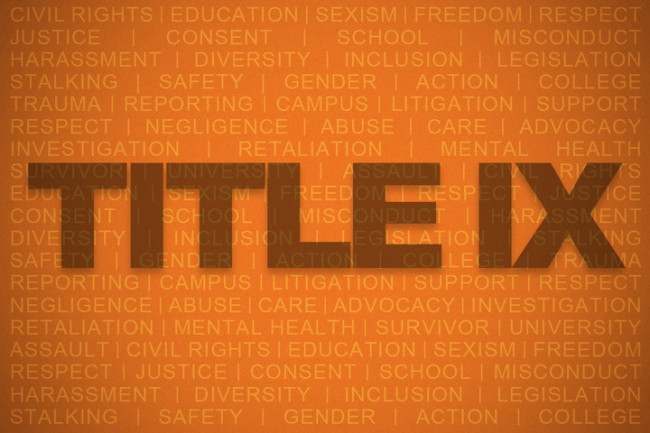You have /5 articles left.
Sign up for a free account or log in.

Illustration by Justin Morrison/Inside Higher Ed
Reversing an earlier decision, the U.S. Court of Appeals for the Ninth Circuit published an opinion Monday stating that the University of Arizona may be held liable for abuse that occurred off campus.
The court previously granted a summary judgment in favor of the university in a unanimous three-judge decision that hinged on the notion, established in the Supreme Court case Davis v. Monroe County Board of Education, that a university must exercise “substantial control over both the harasser and the context in which the known harassment occurs” in order to be held liable for harassment under Title IX of the Education Amendments of 1972, which prohibits gender-based discrimination in federally funded education.
The judges ruled that the university had such control over the harasser, a University of Arizona football player named Orlando Bradford, but not over the context; the victim, fellow student Mackenzie Brown, alleged she was abused on multiple occasions in Bradford’s off-campus apartment while they were in a relationship.
In the rehearing by the entire Ninth Circuit, the court sided with Brown, stating that the university, indeed, had “control” over the “context” of her assault, allowing the case to move forward.
She is suing the university, claiming that officials demonstrated “deliberate indifference” when they failed to report Bradford’s past abuses of two other female students to the athletic director or coaching staff, leading to Brown's own abuse. The team’s head coach has said he would have removed Bradford from the team if he had known of the incidents.
The university did have at least some limited authority over the residence Bradford shared with teammates, according to court filings. The football coach had granted them special permission to live off campus, a privilege “conditioned on good behavior.” Bradford also paid for the residence using money from his athletic scholarship.
In the original opinion, Judge Danielle J. Forrest argued that the university would have had to be more directly responsible for the space and an activity that took place within it to be held liable, citing other cases in which universities were held liable for off-campus assaults because they took place during institutionally sanctioned events.
“Brown was not assaulted on school property or during a school-related activity, and she did not go to Brown’s off-campus apartment for a school-related purpose. Nor did the University have regulatory control over Bradford’s off-campus apartment like Kansas State University had over fraternities in Weckhorst,” Forrest wrote.
But Brown’s lawyers successfully petitioned for the case to be heard in an en banc session—meaning before a panel of 11 Ninth Circuit judges, rather than the three who originally heard the case. Among other things, the lawyers argued that the case involved a legal question of “exceeding importance,” due to the high number of female undergraduate students who are assaulted off campus by fellow students or university employees.
“Artificial geographic boundaries do not prevent that abuse from limiting victims’ access to education,” they wrote.
In the rehearing, the court sided with Brown, stating that the university, indeed, had “control” over the “context” of her assault, allowing the case to move forward.
A key consideration in whether the institution had such control “is whether the school has some form of disciplinary authority over the harasser in the setting in which the harassment takes place,” Judge William A. Fletcher wrote in the reversal. The University of Arizona’s Student Code of Conduct applies to students both on and off campus; Bradford was also subject to the football team’s player rules, reinforcing the idea that the university exercised some authority over him.
“[Yesterday’s] opinion is a victory for Mackenzie and for student survivors across the country,” Alexandra Brodsky, a lawyer representing Brown who argued the case before the en banc court, said in a statement. “Gender violence has grave effects on students’ access to education. For that reason, the civil rights law Title IX requires schools to address known abuse. And as the Ninth Circuit explained [Monday], a school’s power to stop violence—and its responsibility to do so—doesn’t stop at the campus boundary.”
A spokesperson for Arizona’s Attorney General's Office, which is representing the state, declined to comment, as did a spokesperson for the University of Arizona.
Unclear Parameters
Experts differ on whether the case will lead to greater clarity on when institutions can be held liable for off-campus incidents under Title IX.
The question of what it means for a university to have control over the “context” of an assault has long frustrated lawyers and Title IX researchers, according to Brett Sokolow, a leading Title IX expert. While the Davis case established that “substantial control over … the harasser” simply means that the perpetrator must be subject to the disciplinary authority of the university, “substantial control over … the context in which the known harassment occurs” remained somewhat nebulous, he said, and different definitions have appeared in different jurisdictions.
However, the Ninth Circuit’s decision may be the broadest yet, he said, appearing to conflate the boundaries of control over a harasser with the boundaries of control over an incident’s context.
“They’ve merged these two prongs into one. [If] the university’s policies cover the behavior of the harasser regardless of where they are, then you control both the harasser and the context,” he said. “I think that’s a bit of a circular argument.”
In contrast, survivors’ rights advocates believe the opinion speaks to a core idea behind Title IX: ensuring that victims are not denied their right to education due to an act of harassment or violence.
To protect that, universities should have a responsibility to investigate claims even of off-campus incidents between two students, since often-arbitrary campus borders rarely make it any easier for students to continue living and learning on the same campus where their harasser or abuser is a student, said Tracey Vitchers, executive director of It’s On Us, an initiative of the nonprofit Civic Nation aimed at ending campus sexual violence.
“The judges in the case siding with Brown are saying through their ruling: harm happened between two students and the physical location of where that harm happened doesn’t matter,” she said. “For Brown to be able to continue to pursue her education … means that the school is responsible for investigating and adjudicating Brown’s claim against Bradford.”
Brodsky said she believes the ruling may help solidify what it means for a university to have control over an incident’s context.
“As the Ninth Circuit noted in its opinion, its decision aligns with precedent from other appellate courts, including the Fourth Circuit, Seventh Circuit, and Tenth Circuit, as well as some influential trial court opinions,” she wrote in an email. “However, the Ninth Circuit’s opinion is unusual in how directly and thoroughly it evaluated the question of when a school may exercise ‘control’ over an off-campus ‘context,’ which will make this an important decision.”




